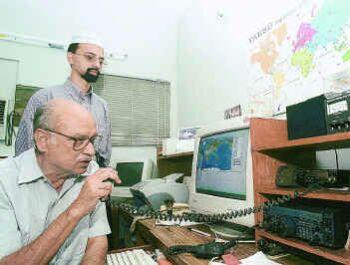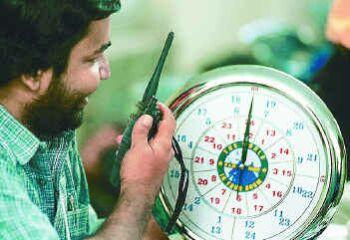HAM strung -1
| Ham radio has a following but its spread is hampered by red tapism, says PRINCE FREDERICK |

WITH FIVE hams (or amateur radio operators) in its ranks, Gopal Madhavan's could be called a family of "ham-handers". Though scattered across the globe they manage to feed each other with the latest gossip every day, with no damage to their bank accounts. How do they do it? Simple. They tune in to a HF band on their amateur radio sets at a pre-arranged time and jabber away!
Hams across the world form a family that resemble Gopal's. They have "Net" meetings every day to exchange pleasantries, to pick each other's brains or simply to hear a familiar voice. Every morning, Chennai hams get off to a sound start. At 7 o' clock on the dot, they make a beeline for their ham sets for a quick session on a VHF band. What follows is a discussion, one that is often directed towards the exploration of a particular subject. "We exchange notes on subjects such as medicine and cookery," says Raju, joint secretary, Madras Amateur Radio Society (MARS). They do not always discuss matters of consequence. Oftentimes, they waffle on about the most trivial things under the sun.
These men and women, however, cannot utter anything that comes to their mind. They have to measure their words, for the personnel at the Wireless Monitoring Office (attached to the Ministry of Communications) at Perungudi have their ears pinned back for any remarks that may run foul of the provisions of the Indian Wireless Telegraph (Amateur Service) Rules 1978. Laid down in broad brush strokes, the "ham-etiquette" allows hams to discuss subjects of a technical or personal nature. And it forbids the dissemination of news, distribution of music and tape recordings and discussions of a political or religious nature. "Small `offences' will invite a warning, bigger ones will ensure cancellation of licence," says Deepan, an amateur radio enthusiast.
The hams in the city better keep their tongues from making any inadvertent utterances, for cancellation of licences will be a big blow to a community that is already "hamstrung" by a slow growth. After about 50 years of hamming, the city has only 1,000 licensed members. What rubs it in is the fact that many of these have allowed their ham sets to gather dust. They are hams only on paper. One thousand may look like a magical number when set against the country's ham population - about 10,000. But in international terms, it is but a drop in an ocean.
However, considering its beginnings Chennai has come a long way. There was just a lackadaisical interest in amateur radio until 1958. In that year an article on the subject, authored by O.M. Venkatesulu, appeared in The Hindu, sowing the seeds of the amateur radio movement in the city. Soon after, a handful of Chennai-based hams (in those days, the city's ham population could be counted on one's fingers) assembled for an informal meeting. It was a humble beginning indeed as the meeting was held in the goods shed of the Madras Beach Railway Station. (Out of this `hazy' summit was born MARS).
In Chennai, as anywhere else in the country, the poor growth of this hobby can be put down to a lack of awareness about its existence, and more still, to teeming misconceptions about it. Noteworthy among which is the one involving the cost of the equipment. "A good HF set (which can be used for worldwide communication) sourced from abroad may cost from Rs. 35,000 to Rs. 65,000 and a VHF or UHF (used for line-of-sight communication) similarly bought may cost Rs. 9000 and upwards. But the good news is that you do not have to pay through your nose to go on the airwaves. Home-brew HF and VHF versions (ham-speak for assembled sets) come at Rs. 5,000 and Rs. 2,000 respectively. All you have to do is take a trip to Richie Street," says Shaikh Sadaqathullah, who tunes in to little details about people living thousands of miles away, thanks to his modest amateur radio station in Muthumari Chetty Street.
"Apart from the initial cost, you do not have to fork out anything," says Gopal. "You can chat for hours on end without paying a red cent." (What is more, amateur radio operators can transmit data and live images digitally, for free. Pecuniary interests should not underlie this form of digital communication, though).
It is said the ham radio movement in Tamil Nadu is writhing under the dead hand of red-tapism. They substantiate their charge with the following. In Chennai, line-of-sight frequencies need repeaters (installed on high-rises or hilltops) to carry the sound waves. Many city-based hams have liberally contributed to the setting up of repeaters here. The Madras Radio Repeater Club has mounted one at Residency Hotel on G.N. Chetty Road, and the VHF Group of Chennai has installed another at the AVM Studios in Vadapalani. These two repeaters were imported at a huge cost. Madhavan, Ganesh and a few other hams found a way around such "wasteful expenditure". They rolled up their sleeves and made a home-brew repeater for a ridiculously economical Rs. 35,000. This repeater is at Kodambakkam. Another has been installed on a makeshift perch at Mathuranthagam. In all these initiatives, the hams paddled their own canoe. "We only expect the Government to lease out a piece of land on a hillock in Karunguzhi Malaipallayam village, near Maduranthagam, to install our repeater there. We placed this request with the powers-that-be in July, 1999. Till date, the officials are dragging their feet on it," says Shaikh.
Having read the afore-mentioned, let not the reader deem the situation utterly bleak. There are a few straws in the wind pointing to a better situation for the country's amateur radio movement in the days to come. In line with the long-standing demand of AMSAT-India, the Indian Space Research Organisation (ISRO) went full steam ahead with the project to launch a satellite exclusively for amateur radio enthusiasts - VUSAT. The satellite is not "taking off the ground" this year as was expected, all credit to some technical glitches. But it is only a matter of time before it lifts up our hams' spirits.

To acquire an amateur radio licence, an aspirant has to sit for an Amateur Station Operators' Certificate (ASOC) examination, which means he has to get his head around the nitty-gritty of radio communication. Madras Amateur Radio Society (MARS) smoothens the way for him by teaching the subject in words of one syllable.
But the problem is usually not the exam, but what follows after it. Even after an aspirant passes the exams with flying colours, he has to wait long for his licence. The reason - the Wireless Planning and Coordination Wing (WPC) in Delhi puts him through a long-winding character verification check. Hams feel the body often makes a production of it, and law-abiding citizens are treated like anti-socials. "Why will anti-socials on the ham opt for licences," they say. "You need not decentralise licensing, but please simplify the procedures. Let the local offices be allowed free rein to issue provisional licences."

| Go Back | Go Top | Go Home |